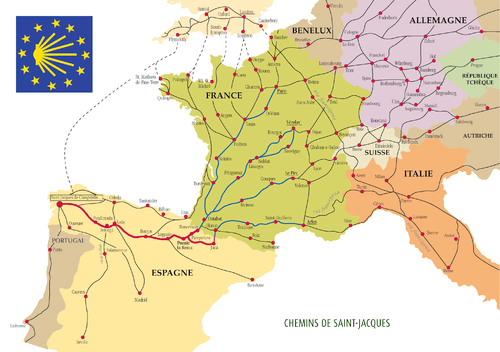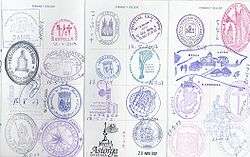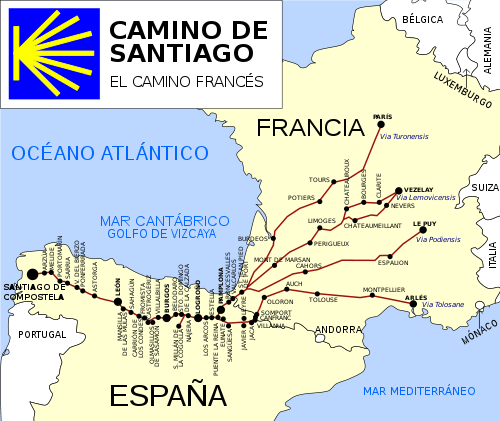Way of St. James
The Way of St. James (Spanish: El Camino de Santiago, El Camino, Galician: O Camiño de Santiago, Ruta Xacobea) is one of the most important Christian pilgrimages, with Santiago de Compostela, Spain, as the final destination.
_3.jpg)
- This article is an itinerary.
Understand
The pilgrimage goes to the Cathedral of Santiago de Compostela in Galicia in northwestern Spain, where tradition has it that the remains of the apostle Saint James are buried. According to the legend, St. James' body was taken to Galicia by boat from Jerusalem and carried inland to where Santiago de Compostela is now located. The pilgrimage is believed by some to be one of three pilgrimages for which the sins of the pilgrim will be forgiven. There are several routes that can be taken, the most popular being the French Way, which begins in Saint-Jean-Pied-de-Port in France. The routes have been inscribed on the UNESCO World Heritage List.
Prepare
The walk from the French border to Santiago de Compostela on the main routes of the French Way beginning at Roncesvalles or Jaca takes about a month. Speed hikers can make it in as little as two weeks (about the time bicyclists usually require), but that requires walking 40 km or more each day.
While most of the route is fairly gentle with only a few long ascents, some days can be challenging. Over the past 20 years a great deal of effort has gone into improving the walkers' route, and most of the route is now well marked, reasonably well surfaced, and separated from the increasingly heavy traffic on Spanish highways. If one begins in France, the route passes over two major mountain chains and several smaller ones. There is a joke that the Camino never meets a mountain it doesn't cross. While that is not really true, there are many ascents and descents, and some of the latter can be quite steep.
One needs to be in reasonably good condition and to have good hiking boots. If you wish to camp, you need to carry clothing and a sleeping bag in a comfortable backpack. But you can stay in hostels (called albergues or refugios) for low cost. Unless you plan to camp in the most crowded months of the summer season, you do not need to carry camping and cooking gear.
Get in

One can start in France at Le Puy en Velay or Saint-Jean-Pied-de-Port and follow one of the routes of Santiago de Compostela in France to Spain.
Other popular starting points are Lisbon in Portugal or Jaca, Sevilla in Spain.
Do
To earn the compostela (certificate of accomplishment) one needs to walk a minimum of 100 km or cycle at least 200 km. For walkers, that means in practical terms starting in the small city of Sarria, because it has transportation connections by bus and rail to other places in Spain.
While many pilgrims only do that final portion of the route, there are great rewards for starting much further away. Some Europeans walk from their homes, following one of the many routes from virtually all corners of central and western Europe. Most of those routes, save the maritime one from the UK and the routes from Portugal and those from southern Spain, converge to funnel walkers across one of two Pyrenees passes, Somport or the route between St. Jean Pied-de-Port and Roncesvalles. A few days onward, those two routes converge at Puente la Reina and follow the traditional French Way across Navarra, La Rioja, Castilla y León, over the pass at O Cebreiro and on to Santiago.
If one has the time and inclination, there are several lovely routes across France leading to Somport and St. Jean Pied-de-Port, the most popular the Chemin St. Jacques beginning at Le Puy-en-Velay and passing through Conques enroute to St. Jean Pied-de-Port. Another French route, the Chemin de Arles passes through the southern tier of Languedoc toward Oloron St. Marie and the pass into Spain at Somport. While those routes are beautiful and interesting, they add weeks to the pilgrimage.
Due to time constraints, many non-Europeans begin at St. Jean Pied-de-Port in France or Roncesvalles in Spain. Beginning in the French city means the first day of walking requires a long and steep climb, perhaps the most arduous single day on the route. Roncesvalles, steeped in history and the site of the defeat and death of Charlemagne's lieutenant Roland, is a usual starting point for Spaniards.
Walk
.jpg)

Once on the Camino, the pilgrim has three duties: to sleep, to eat, and to walk. Those duties are made less onerous by paying attention to the quality of the path, a large number of bars, restaurants, and cafes, and the albergues.
Alternatively it is possible to walk the Camino with various travel companies that have set itineraries and will transfer your luggage between your overnight locations, leaving you free to enjoy the Camino in style and comfort.
Cycle
More and more pilgrims decide to come to Santiago by bike, it's the second most used way of doing it. The first thing that you have to bear in mind is that it's not possible to do all the original way by bike; sometimes you will have to change the route a little bit to get to the end of the stages.
Before starting, you have to decide which way you are going to do, the route that you are going to follow, and also the season in which you are going. There is not a perfect way for a cyclist; all the ways have easy parts and other parts that are a little bit more difficult. Nevertheless, the easiest ways for cyclist are the French Way and the English Way. As for in which season to do it, it would be perfect in spring or autumn, avoiding the hardest months of the year: November, December and January; during these months, there's snow in many stages of the way. Avoid the hottest months: July and August, because you could suffer a heat stroke.
Passport and stamps
Pilgrims wishing to receive their compostela at the end of the walk must first provide their Pilgrim's Passport. This document can be obtained at a pilgrim office, such as the ones run by Friends of the Camino. At each albergue, and sometimes at city centers and bars, pilgrims receive a unique stamp on their passport, serving as proof that the pilgrim actually walked through the city or town in question. The passport also proves to the albergue owner that the passport holder is a true pilgrim, not just someone looking for a cheap place to stay.
Stamps are also a way for cities and albergues to make their literal mark on a pilgrim's Santiago journey. In Santiago de Compostela, shops will offer to "emplasticar," or laminate the passport to make a souvenir. Hundreds of stamps exist for each route of the Camino. Pilgrims can add to the database of stamps on websites built to keep track of the unique designs.
Routes
This section is an attempt to encourage sharing practical information about travelling the Camino. Peregrinos (Spanish for "pilgrim" in English or "pèlerin" in French) as they are called in Spain should feel free to use the information in this section and contribute to it. Albergues, restaurants and other accommodations all change with time, and this information should be updated accordingly.
There are several different routes that can be called The Way of St. James, such as those listed below. There are also many stopping points along each route, and none are mandatory. The stopping points listed will vary for each peregrino, just like every peregrino's experience will be different. The route listings are by no means complete, but are an attempt to share information about the possibilities.
A pilgrim interested in walking less crowded routes may consider starting before the more popular starting lines, including beginning in Bayonne and crossing the Valley of Baztan to Pamplona. This takes just under a week and is less travelled than the Saint-Jean-Pied-du-Port route to Pamplona. Beware of the poorly marked trail during the last two days, though one needs only follow the valley.
The French Way

- Main article: French Way
The French Way (Spanish: Camino Francés) is the most popular of the routes of the Way of St. James. For a description of the route from Saint-Jean-Pied-de-Port across the French border, please refer to the main article. For the routes to there from different points in France, see Routes to Santiago de Compostela from France.
The Aragonese Way
The Aragonese Way comes down from the Somport pass in the Pyrenees and makes its way down through the old kingdom of Aragon.
The Northern Way
The Northern Way, while definitely less populated, is not as well developed and there may be longer distances between established Albergues.
The Tunnel Way
The Tunnel Way is also known as the Tunnel Route, the Basque Inland Route and the San Adrian Route.
The English Way
The English Way is traditionally for pilgrims who traveled to Spain by sea and disembarked in Ferrol or A Coruña.
The Portuguese Way
The Portuguese Way is the route from Porto in Portugal to Santiago de Compostela in Spain of the Way of St. James.
The Silver Route
The Camino de Madrid
The Camino de Madrid goes northwards from Madrid, through Segovia and near Valladoid, joining the Camino Francés at Sahagún.
The Camino del Ebro
The Camino del Ebro starts in Catalonia at Sant Jaume d'Enveja near Deltebre.
The Camino de Santiago de Soria
Sometimes known as the Camino Castellano-Aragonés, this camino leaves the Camino del Ebro at Gallur and goes past Soria to Santo Domingo de Silos, where it joins the Camino de la Lana.
The Camino de la Lana
The Camino de la Lana (sometimes Ruta de la Lana), or wool road, leaves Alicante and heads mainly northwards for 670 km, joining the Camino Francés at Burgos.
The Camino de Levante
The Camino de Levante starts at Valencia and crosses Castille-La Mancha, passing through towns and cities including Toledo, El Toboso, Ávila and Medina del Campo, joining the Via de la Plata at Zamora.
The Camino del Sureste
The Camino del Sureste starts at Alicante and follows a broadly similar route as the Camino del Levante from Albacete until Medina del Campo, where the routes bifurcate, with the Sureste heading northwards to Tordesillas, joining the Via de la Plata at Benavente, while the Levante goes westwards to Toro and Zamora.
The Camino de Torres
The Camino de Torres starts in Salamanca, goes past Ciudad Rodrigo, crosses the Portuguese border near Almeida, continues past Braga and joins the Camino Portugués at Ponte de Lima.